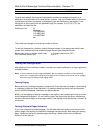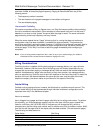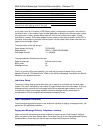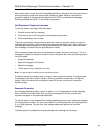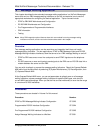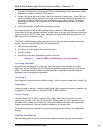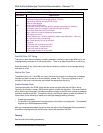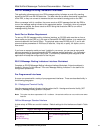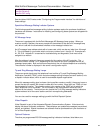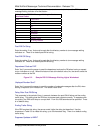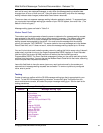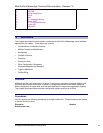
Mitel NuPoint Messenger Technical Documentation - Release 7.0
This parameter allows you to include a T code (Go Off-Hook, Wait for Dial Tone) if you are
integrating with most PBXs, or delete a T code in the dial string if you are integrating with cellular
or other non-PBX equipment that cannot produce a dial tone.
The outdial string consists of the following parts:
• Initial T code produced by this parameter, if enabled
• PBX special access code parameter, if any
• Appropriate on or off dial string parameter (the pre-DN on dial string, pre-DN off dial string,
post-DN on dial string, or post-DN off dial string).
Note: If you enable this parameter ("enabled" is the default), do not enter a T code as the first part of the
special access code. If you do, the server waits for two separate dial tones. But two separate dial
tones cannot occur in this context, so every message indicator request fails.
If you disable this parameter, you typically begin the special access code with the S (Go Off-
Hook, Do Not Wait for Dial Tone) code.
PBX Special Access Code
Some PBXs require the server to dial a special access code before sending message indicators
requests. The special access code indicates to the PBX that one of its special features is about
to be invoked. Table 5-1 lists the characters allowed in this code.
Note: The NuPoint Messenger server automatically configures a T (Go Off-Hook, Wait for Dial Tone) as
the first part of the outdial string. DO NOT enter a T as the first part of the special access code
because then the server waits for two separate dial tones.
There is no default PBX special access code.
Dial Tone Confirmation
Answer Yes to this parameter only if (1) a PBX special access code is required and (2) if, after
the special access code has been sent, the PBX expects the server to wait for a dial tone before
the server outdials any other digits. The default is No (no wait).
Pre-DN On or Off String
This string is sent before the directory number (extension number) to instruct the PBX to turn the
message waiting indicator on or off at that station. There is no default Pre-DN on or off string.
Note: Never enter a T as the first part of the Pre-DN on string because then the server waits for two
separate dial tones.
Enter the coding, if any, that must be sent before the directory number to turn message waiting
indicators on or off.
Suppress Updates to MWL
Each time a mailbox receives a new message, the server sends a request to the PBX to turn on
the message indicator. However, if the user logs into the server, listens to all the new messages,
and logs out, a single indicator-off request is sent to the PBX. Some PBXs stack the indicator-on
requests. Then, when the single indicator-off request is sent, it cancels only one of the indicator-
on requests, and the message indicator stays on. To prevent the server from sending an
indicator-on request when the message indicator is already activated, leave this feature at the
©
Copyright 2002, Mitel Networks Corporation 69



